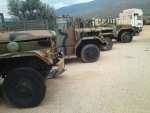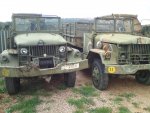My father and I after alot of measurements got rid of his 1993 Dodge Cummins 350 4wd due to the fact that we could not readily get a multifuel to fit, we had built up the cummins in our own shop from the ground up to about 450 hp (ported head, injection work, turbo work,5" exhaust, 160 H.P. 2-stage home grown L.P. kit, balanced, ARP fasteners, reduced compression etc.) It got very good fuel economy and would beat the later model mustang cobras. However, being that it was a single wheel truck and we haul my 1975 Massey Ferguson 1155 to shows etc. and it weighs 14,000 lbs, this was very dicey with a tri-axle bumper hitch trailer! (tail wagging the dog) after we built the multifuel engine for my M-35 (ported heads, combustion chamber mods, gasket matching, custom adjustable governor springs, internal pump work, GOOD head gaskets, custom tuned exhaust, trial and error power timed injection, (doesn't end up anywhere near where you think it would) and 3300 rpm red line, we wanted the power of the multifuel in the Dodge as well, especially the bottom end torque. Fuel economy would have suffered but not a great ammount as the M-35 gets 12-15 empty. We have a 20 ton air brake trailer that we pull now as well as other trailers and often use it to move mobile homes and tow bar other deuces or 5 tons. (no down shifting for hills) and have in 8 years never hurt anything. Part of the longevity was oiling mods as well as a control in the cab that I can use to limit maximum boost when loaded to about 15 psi, (5-9 is stock and where it is set the rest of the time except for when showing off!) it will make enough to peg a 30 pound gauge but, this is not good on engine for more than a few seconds (1 pull up through the gears empty) I had a 2008 Dodge Cummins that thought he would pass me in a double yellow and leave me sit, I let him get around and then I pushed him up to about 75 mph letting off to keep from hitting him! (runs 62 in 4th and goes from 25 MPH in third to 67 mph in fifth in a measured 7.0 seconds) perhaps next I will put that propane kit from the Dodge on it and a home built aftercooler with multipoint water injection and custom mapped turbo (pipe dreams$$$$) However the rest of the drive line will need attention as the clutch has about all it wants right now. Got tired of split cylinders, blown head gaskets, and cam/lifter troubles and poor port flow with the Cummins (using the marine gaskets and Hasley's tourque specs on ARP studs helped alot but didn't seem to cure gasket probs). These engines were an economy engine designed by International harvester and Cummins to replace the more expensive 466 ci in their farm equipment, however, they are very impressive and tough engines and the probably the best engine ever put in a pickup.) 359 ci at 15:1 to 17:1 just can't torque down low like 478 ci (turned up) and 21:1 compression.




